Student: Difference between revisions
| [pending revision] | [pending revision] |
No edit summary |
ClueBot NG (talk | contribs) m Reverting possible vandalism by 119.73.116.99 to version by Ali mjr. False positive? Report it. Thanks, ClueBot NG. (1943217) (Bot) |
||
| Line 1: | Line 1: | ||
{{Other uses}} |
|||
{{Other uses}} ZAID ASIF SIDDIQUE IS THE MOST CREATIVE STUDENT OF THE YEAR |
|||
{{redirect|Freshman year}} |
{{redirect|Freshman year}} |
||
{{multiple issues| |
{{multiple issues| |
||
Revision as of 11:17, 7 September 2014
This article has multiple issues. Please help improve it or discuss these issues on the talk page. (Learn how and when to remove these messages)
|
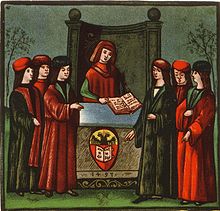
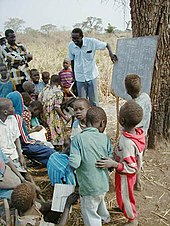
A student (Also Pupil) is a learner, or someone who attends an educational institution. In some nations, the English term (or its cognate in another language) is reserved for those who attend university, while a schoolchild under the age of eighteen is called a pupil in English (or an equivalent in other languages), although in the United States and in Australia a person enrolled in grades K–12 is often called a student. In its widest use, student is used for anyone who is learning, including mid-career adults who are taking vocational education or returning to university.
International variations

Asia
Brunei
Education is free in Brunei Darussalam not limited to government educational institutions but private educational institutions too. There are mainly two types of educational institutions namely government or public as well as private institutions. Several stages have to be undergone by the prospective students leading to higher qualifications such as Bachelor's Degree.
- Primary School (Year 1 to 6)
- Secondary School (Year 7 to 11)
- High School [or also known as the Sixth Form Centers] (Year 12 to 13)
- Colleges (Pre-University to Diploma)
- University Level (Undergraduate, Postgraduate and Professional)
It takes six and five years to complete the primary and secondary levels respectively. Upon completing these two crucial stages, students have freedom to progress the sixth-form centers, colleges or probably straight to employment. Ahead of times, these students will be leaded to undertaking the university level programs in both, government and private university colleges.
Pakistan
In Pakistan 12-year school is categorised in three stages: Primary school, Secondary school and Higher Secondary school. It takes 5 years for a student to graduate from Primary school, 3 years for Secondary school and 2 years for Higher Secondary school and 2 years for College/pre-university college. On average Bachelor's degree spans over three years with exception to engineering degree that takes 4 years and 2 years Master's degree.
Philippines
The Philippines is currently in the midst of a transition to a K-12 (also called K+12) basic education system. Education ideally begins with one year of kinder. Once the transition is complete, elementary or grade school comprises grades 1 to 6. Although the term student may refer to learners of any age or level, the term pupil is used by the Department of Education to refer to learners in the elementary level, particularly in public schools. Secondary level or high school comprises two major divisions: grades 7 to 10 will be collectively referred to as 'junior high school', whereas grades 11 to 12 will be collectively referred to as 'senior high school'. The Department of Education refers to learners in grade 7 and above as students.
After basic education, students can opt to take a bachelor's (undergraduate) degree at a higher education institution (i.e. a college or university), which normally lasts for four years though the length of some courses may be longer or shorter depending on the institution.
India
In India also, 12-year school is categorized in three stages: Primary school, Secondary school and Higher Secondary school. In some states like Maharashtra and Andhra Pradesh, 2 year Higher Secondary is Junior College and the Institute is different from regular school. For College its average 3 years for Bachelor's degree (exception B. Tech. and B.E. i.e. 4 years) and 2 years Master's degree.
Iran

In Iran 12-year school is categorised in three stages: Elementary school, Junior high school and High school. It takes 5 years for a student to graduate from elementary school, 3 years for junior high school and 3 years for high school and 1 year for pre-university college( independed on your field) . After graduating from high school(or pre-university if needed), students acquire a diploma. Having a diploma, a student can participate in the Iranian University Entrance Exam or Konkoor. The university entrance exam is conducted every year by National Organization of Education Assessment, an organization under the supervision of the Ministry of Science, Research and Technology.[1] Members of the Baha'i religion, a much-persecuted minority are officially forbidden to attend university, in order to prevent members of the faith becoming doctors, lawyers or other professionals.
Australia
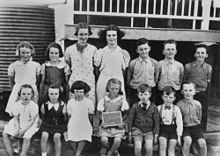
In Australia, after preschool, which is not compulsory, children begin primary school, usually after their fifth birthday. In New South Wales the first year is called 'kindergarten', in Victoria 'prep', and in South Australia 'reception'; students then continue on to 'grade one' through to 'grade six', except in Western Australia, South Australia and Queensland, where primary school currently continues to 'grade seven'. However, by 2014 all states will conclude primary schooling at 'year six'. Students begin secondary school (also known as high school) in 'year seven' (or 'year eight' in WA and Qld)and continue to 'year twelve'. Year seven/eight is referred to as the junior school, nine/ten is referred to as 'middle school' and year ten/eleven through to twelve as 'senior school'. After year twelve, students may pursue tertiary education at university or TAFE (technical and further education). The general term for people in primary, secondary and tertiary education is 'students'.
New Zealand
In New Zealand, after kindergarten or pre-school, which is attended from ages three to five, children begin primary school, 'Year One', at five years of age. Years One to Six are Primary School, where children commonly attend local schools in the area for that specific year group. Then Year Seven and Year Eight are Intermediate, and from Year Nine until Year Thirteen, a student would attend a secondary school or a college. Primary School children are known as Pupils and Intermediate/Secondary School children are known as Students.
Europe
Finland

In Finland a student is called "opiskelija" (plural being 'opiskelijat'), though children in compulsory education are called "oppilas" (plural being 'oppilaat'). first level of education is "esikoulu" (literally 'preschool'), which is optional. Children attend esikoulu the year they turn six, and next year they start attending "peruskoulu" (literally "basic school", corresponds to American elementary school, middle school and junior high), which is compulsory. Peruskoulu is divided to "alakoulu" (years 1 through 6) and "yläkoulu" (years 7 through 9). After compulsory education most children attend second level education (toisen asteen koulutus), either lukio (corresponds to high school) or ammattikoulu (Vocational School), at which point they are called students (opiskelija). Some attend "kymppiluokka", which is a retake on some yläkoulu's education.
To attend ammattikorkeakoulu (University of applied sciences) or a university a student must have a second level education. The recommended graduation time is five years. First year students are called "fuksi" and students that have studied more than five years are called "N:nnen vuoden opiskelija" (Nth year student).
France
In some French schools, a bleu or "bizuth" is a first-year student. Second-year students are sometimes called "carrés" (squares). Some other terms may apply in specific schools, some depending on the classe préparatoire aux grandes écoles attended. The generic term "Étudiant" (lit. Student) applies specifically to someone attending a University or a school of a similar level, that is to sat pupils in a cursus reserved to people already owning a Baccalauréat.
Germany
In Germany, the German cognate term "student" is reserved for those attending a university. University students in their first year are colloquially called Ersties ("firsties"). Different terms for school students exist, depending on which kind of school is attended by the student. The general term for a person going to school is Schüler or Schülerin. Students attending a university preparatory school are called Gymnasiasten, while those attending other schools are called Hauptschüler or Realschüler. Students who graduate with the Abitur are called Abiturienten. The abbreviation stud. + the abbreviation of the faculty p. e. phil. for philosophiae is a post-nominal for all students of a baccalaureus course. The abbreviation cand. for candidatus + the abbreviation of the faculty is given as a post-nominal to those studying for a mastership. First name surname, stud. phil. or First name surname, cand. jur.
Ireland
In Ireland, pupils officially start with primary school which consists of eight years: junior infants, senior infants, first class to sixth class (ages 5–11). After primary school, pupils proceed to the secondary school level. Here they first enter the junior cycle, which consists of first year to third year (ages 12–15). At the end of third year, all students must sit a compulsory state examination called the Junior Certificate. After third year, pupils have the option of taking a "transition year" or fourth year (usually at age 15-16). In transition year pupils take a break from regular studies to pursue other activities that help to promote their personal, social, vocational and educational development, and to prepares them for their role as autonomous, participative and responsible members of society. It also provides a bridge to enable pupils to make the transition from the more dependent type of learning associated with the Junior Cert. to the more independent learning environment associated with the senior cycle.
After the junior cycle pupils advance to the senior cycle, which consists of fifth year and sixth year (usually ages between 16 to 18). At the end of the sixth year a final state examination is required to be sat by all pupils, known as the Leaving Certificate. The Leaving Cert. is the basis for all Irish pupils who wish to do so to advance to higher education via a points system. A maximum of 600 points can be achieved. All higher education courses have a minimum of points needed for admission.
At Trinity College, Dublin under-graduate students are formally called "junior freshmen", "senior freshmen", "junior sophister" or "senior sophister", according to the year they have reached in the typical four year degree course. Sophister is another term for a sophomore, though the term is rarely used in other institutions and is largely limited to Trinity College Dublin.
At university the term "fresher" is used to describe new students who are just beginning their first year. The term, "first year" is the more commonly used and connotation-free term for students in their first year. The week at the start of a new year is called "Freshers' Week" or "Welcome Week", with a programme of special events to welcome new students. An undergraduate in the last year of study before graduation is generally known as a "finalist."
Italy
In Italian, a matricola is a first-year student. Some other terms may apply in specific schools, some depending on the liceo classico or liceo scientifico attended.
Sweden
In Sweden, only those studying at university level are called students (student, plural studenter). To graduate from upper secondary school (gymnasium) is called ta studenten (literally "to take the student"), but after the graduation festivities, the graduate is no longer a student unless he or she enrolls at university-level education. At lower levels, the word elev (plural elever) is used. As a general term for all stages of education, the word studerande (plural also studerande) is used, meaning 'studying [person]'.
United Kingdom
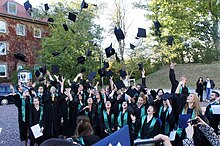
Traditionally, the term "student" is reserved for people studying at university level in the United Kingdom. Children studying at school are called "pupils" or "schoolchildren" (or "schoolboys" or "schoolgirls"). However, the American English use of the word "student" to include pupils of all ages, even at elementary level, is now spreading to other countries, and is occasionally found in the UK (particularly in the state sector), as well as Australia and Singapore. In South Africa, the term "learner" is also used.
In England and Wales, teenagers who attend a college or secondary school for further education are typically called "sixth formers". If pupils follow the average pattern of school attendance, pupils will be in "year 12" between the ages of 16 and 17, and "year 13" between 17 and 18, however many schools still refer to them as the "lower sixth" and "upper sixth" or "AS" and "A2". The successful completion of VI Form and the acquisition of A Level qualifications is the traditional path to university education.
In Scotland, pupils sit Highers at the end of fifth year (when aged 16–17) after which it is possible for them to gain entry to university. Many pupils, however, choose to remain at school for a sixth year to grow in maturity and to gain extra qualifications (e.g. Advanced Highers).
At universities in the UK, the term "fresher" is used informally to describe new students who are just beginning their first year. Although it is not unusual to call someone a fresher after their first few weeks at university, they are typically referred to as "first years" or "first year students".
The ancient Scottish University of St Andrews uses the terms "bejant" for a first year (from the French "bec-jaune" – "yellow beak", "fledgling"). Second years are called "semi-bejants", third years are known as "tertians", and fourth years, or others in their final year of study, are called "magistrands".
In England and Wales, primary school begins with an optional "nursery" year followed by reception and then move on to "year one, year two" and so on until "year six". In state schools, children join secondary school when they are 11–12 years old in what used to be called "first form" and is now known as "year 7". They go up to year 11 (formerly "fifth form") and then join the sixth form, either at the same school or at a separate sixth form college. A student entering a private, fee-paying school (usually at age 13) would join the "third form" — equivalent to year 9. Many schools have an alternate name for first years, some with a derogatory basis, but in others acting merely as a description — for example "shells" (non-derogatory) or "grubs" (derogatory).
In Northern Ireland and Scotland, it is very similar but with some differences. Pupils start off in nursery or reception aged 3 to 4, and then start primary school in "P1" (P standing for primary) or year 1. They then continue primary school until "P7" or year 7. After that they start secondary school at 11 years old, this is called "1st year" or year 8 in Northern Ireland, or "S1" in Scotland. They continue secondary school until the age of 16 at "5th year", year 12 or "S5", and then it is the choice of the individual pupil to decide to continue in school and (in Northern Ireland) do AS levels (known as "lower sixth") and then the next year to do A levels (known as "upper sixth"). In Scotland, students aged 16–18 take Highers, followed by Advanced Highers. Alternatively, pupils can leave and go into full-time employment or to start in a technical college.
Large increases in the size of student populations in the UK and the effect this has had on some university towns or on areas of cities located near universities have become a concern in the UK since 2000. A report by Universities UK, "Studentification: A Guide to Opportunities, Challenges and Practice" (2006) has explored the subject and made various recommendations.[2] A particular problem in many locations is seen as the impact of students on the availability, quality and price of rented and owner-occupied property.
North America
Canada
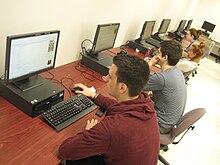
Education in Canada is within the constitutional jurisdiction of the provinces, and the overall curriculum is overseen by the provincial governments. As there is no overall national coordinating authority, the way the educational stages are grouped and named differs from region to region. Education is generally divided into primary education, followed by secondary education, and post-secondary education. Primary and secondary education are generally divided into numbered grades from 1 to 12, although the first grade may be preceded by kindergarten (optional in many provinces). Ontario and Quebec offer a pre-kindergarten, called a "junior kindergarten" in Ontario, and a "garderie" in Quebec.
Education in Ontario once involved an Ontario Academic Credit (OAC) as university preparation, but that was phased out in 2007, and now all provinces except Quebec have 12 grades. The OAC was informally known as "grade 13" and the name was also used to refer to the students who took it.
Education in Quebec differs from the other provinces in that it has an école primaire (literally "primary school") consisting of grades 1-6, and an école secondaire (literally "secondary school") consisting of secondaries I-V. Secondaries I-V are equivalent to grades 7-11. A student graduating from high school (grade 11) can then either complete a three year college program or attend a two year pre-university program required before attending university. In some English High Schools, as well as in most French schools, high school students will refer to secondary 1-5 as year one through five. So if someone in Secondary three is asked "what grade/year are you in?" they will reply "three" or "sec 3". It is presumed that the person asking the question knows that they are not referring to "Grade 3" but rather "Secondary 3". This can be confusing for those outside of Quebec.
In some provinces, grades 1 through 6 are called "elementary school", grades 6 through 8 are called "middle school" or "junior high school", and grades 9 through 12 are considered high school. Other provinces, such as British Columbia, mainly divide schooling into elementary school (Kindergarten to grade 7) and secondary school (grades 8 through 12). In Alberta and Nova Scotia, elementary consists of kindergarten through grade 6. Junior high consists of Grades 7-9. High school consists of Grades 10-12. In English provinces, the high school (known as academy or secondary school) years can be referred to simply as first, second, third, and fourth year. Some areas call it by grade such as grade 10, grade 11, and grade 12.
The difference between college and university is significantly different from in the United States or even the United Kingdom. A Canadian college is more similar to an American community college. In contrast, a Canadian university is comparable to an American university. In Canada, colleges are generally geared for individuals seeking applied careers, while universities are geared for individuals seeking more academic careers.
University students are generally classified as first, second, third, or fourth-year students, and the American system of classifying them as "freshmen", "sophomores", "juniors", and "seniors" is seldom used or even understood in Canada. In some occasions, they can be called "senior ones", "twos", "threes", and "fours".
United States
In the United States, the first official year of schooling is called kindergarten, which is why the students are called kindergarteners. Kindergarten is optional in most states, but few students skip this level. Pre-kindergarten, also known as "preschool" (and sometimes shortened to "Pre-K") is becoming a standard of education as academic expectations for the youngest students continue to rise. Many public schools offer pre-kindergarten programs.
In the United States there are 12 years of mandatory schooling. The first eight are solely referred to by numbers (e.g. 1st grade, 5th grade) so students may be referred to as 1st graders, 5th graders, etc. Upon entering high school, grades 9 through 12 (high school) also have alternate names for students, namely Freshman, Sophomore, Junior and Senior. The actual divisions of which grade levels belong to which division (whether elementary, middle, junior high, or high school) is a matter decided by state or local jurisdictions.
Accordingly, college students are often called Freshman, Sophomores, Juniors, and Seniors (respectively), unless their undergraduate program calls for more than the traditional 4 years.
First year
The first year of college or high school is referred to as Freshman year. A freshman (slang alternatives that are usually derogatory in nature include "fish", "new-g", "fresher", "frosh", "newbie", "freshie", "snotter", "fresh-meat", "skippie", etc.) is a first-year student in college, university or high school. The less-common[citation needed] gender-neutral synonym "first-year student" exists.
Second year
In the U.S., a sophomore, also called a "soph," is a second-year student. Outside the United States, the term Sophomore is rarely used, with second-year students simply called "second years". Folk etymology indicates that the word means "wise fool"; consequently "sophomoric" means "pretentious, bombastic, inflated in style or manner; immature, crude, superficial" (according to the Oxford English Dictionary). It is widely assumed to be formed from Greek "sophos", meaning "wise", and "moros" meaning "foolish", although the etymology suggests an origin from the now-defunct "sophumer", an obsolete variant of "sophism".[3]
Post-second year

In the U.S., a Junior is a student in the penultimate (usually third) year and a Senior is a student in the last (usually fourth) year of college, university, or high school. A student who takes more than the normal number of years to graduate is sometimes referred to as a "super senior".[4] This term is often used in college, but can be used in high school as well. The term Underclassman is used to refer collectively to Freshmen and Sophomores, and Upperclassman to refer collectively to Juniors and Seniors, sometimes even Sophomores. The term Middler is used to describe a third-year student of a school (generally college) that offers five years of study. In this situation, the fourth and fifth years would be referred to as Junior and Senior years, respectively, and the first two years would be the Freshman and Sophomore years.
Graduate Students
A Graduate student is a student who continues his/her education after graduation. Some examples of graduate programs are: law school, medical school, veterinary school. Degrees earned in Graduate programs are the Master’s degree or a Doctorate degree.
Vocational School
Students attending vocational school focus on their jobs and learning how to work in specific fields of work. A vocational program typically takes much less time to complete than a four-year degree program, lasting 12–24 months.[5] Liberal Arts that are required in four-year Universities are less important to these students because the skills necessary for their careers take precedence in order for a timely completion of the program.
Jamaica
In Jamaica, children usually start attending school at the age of two, where they would go to what is known as basic school or kindergarten. They would then move on to the primary or preparatory school at about the age of five or six usually. After six years at this level, students would move on to the secondary school level. After five years of education at this level, some students finish (fifth form or 11th grade) and graduate at sixteen years old. Some move on to the tertiary level, while some may choose to attend 6th form (12th and 13th grade) then move on to university or college or straight into the working world.[citation needed]
Mature students
A mature, non-traditional, or adult student in tertiary education (at a university or a college) is normally classified as an (undergraduate) student who is at least 21–23 years old at the start of their course and usually having been out of the education system for at least two years. Mature students can also include students who have been out of the education system for decades, or students with no secondary education. Mature students also make up graduate and postgraduate populations by demographic of age.
Student pranks
University students have been associated with pranks and japes since the creation of universities in the Middle Ages.[6][7][8][9][10] These can often involve petty crime, such as the theft of traffic cones and other public property,[11] or hoaxes. It is also not uncommon for students from one school to steal or deface the mascot of a rival school.[12] In fact, pranks play such a significant part in student culture that numerous books have been published that focus on the issue.[13][14] Pranks may reflect current events,[15] be a form of protest or revenge, or have no other purpose than for the enjoyment of the prank itself.
Other terms
- Students who are repeating a grade level of schooling due to poor grades are sometimes referred to as having been "held back" or "kept back". In Singapore they are described as "retained". In the Philippines they are called "repeater".
- The term 'pupil' (originally a Latin term for a minor as the ward of an adult guardian, etc.) is used in some Commonwealth primary and secondary schools (particularly in England and Wales) instead of "student", but once attending higher education such as sixth-form college, etc., the term "student" is standard. The term pupil is also used in the Philippines by the Department of Education to refer to learners currently in elementary school; the term student is used for by the Department of Education for learners in high school.
- The United States military academies officially use only numerical terms, but there are colloquial expressions used in everyday speech. In order from first year to fourth year, students are referred to as "fourth-class", "third-class", "second-class", and "first-class" cadets or midshipmen. Unofficially, other terms are used, for example at the United States Military Academy, freshmen are called "plebes", sophomores are called "yearlings" or "yuks", juniors are called "cows", and seniors are called "firsties". Some universities also use numerical terms to identify classes; students enter as "first-years" and graduate as "fourth-years" (or, in some cases, "fifth-years", "sixth-years", etc.).
Idiomatic use
"Freshman" and "sophomore" are sometimes used figuratively, almost exclusively in the United States, to refer to a first or second effort ("the singer's sophomore album"), or to a politician's first or second term in office ("freshman senator") or an athlete's first or second year on a professional sports team. "Junior" and "senior" are not used in this figurative way to refer to third and fourth years or efforts, because of those words' broader meanings of "younger" and "older." A junior senator is therefore not one who is in a third term of office, but merely one who has not been in the Senate as long as the other senator from their state. Confusingly, this means that it is possible to be both a "freshman Senator" and a "senior Senator" simultaneously: for example, if a Senator wins election in 2008, and then the other Senator from the same state steps down and a new Senator elected in 2010, the former Senator is both senior Senator (as in the Senate for two years more) and a freshman Senator (since still in the first term).
International Students' Day
International Students' Day commemorates the anniversary of the 1939 Nazi storming of the University of Prague after student demonstrations against the German occupation of Czechoslovakia. Germans closed all Czech universities and colleges, sent over 1200 students to Nazi concentration camps, and had nine student leaders executed (on November 17).[16]
See also
- Dormitory
- Student activism
- School bullying
- Bullying in academia
- Bullying in teaching
- Freshman 15
- International student
- Student orientation
- Student resources
- Studentification
- University student retention
References
- ^ [1]
- ^ Studentification: A Guide to Opportunities, Challenges and Practice
- ^ "Online Etymology Dictionary". Etymonline.com. Retrieved 2012-12-08.
- ^ Definition of a super senior retrieved 5 October 2006.
- ^ Minnesota Vocational and Technical Schools; http://www.rwm.org/rwm/tf_min.html
- ^ "Seeley G. Mudd Manuscript Library: FAQ Student pranks". Princeton.edu. 2012-04-24. Retrieved 2012-12-08.
- ^ "Blog Archive » Student Pranks". Kiwiblog. 2006-10-21. Retrieved 2012-12-08.
- ^ Watts, Jonathan, "Student prank that gave the Chinese a fit of the willies", The Guardian, London, 1 November 2003.
- ^ Epigram Online - Alarming consequences for student pranks[dead link]
- ^ Ayala, Jamie, "Sticky student prank injures teacher", FOX11AZ.com, Tucson, Arizona, 14 June 2007.
- ^ "Nightmare on student street".
- ^ Miller, Eli, "Oski and Tree Have Rowdy, Long History"[dead link], The Daily Californian, 22 November 2002.
- ^ Peterson, T.F., Nightwork: A History of Hacks and Pranks at MIT, 2003.
- ^ Steinberg, Neil, If at All Possible, Involve a Cow: The Book of College Pranks, 1992.
- ^ "MIT 'hacks' mark Sept. 11 with a fake fire truck", The Boston Globe, 11 September 2006.
- ^ "The 17th of November: Remembering Jan Opletal, martyr of an occupied nation". Radio Prague.
